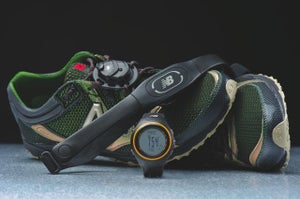New perk! Get after it with local recommendations just for you. Discover nearby events, routes out your door, and hidden gems when you sign up for the Local Running Drop.
The end of the triathlon racing season is fast approaching and the off-season is more than just a time to rest—it’s an opportunity to jump to another level of fitness in one sport. If you are looking to reinvent yourself as a runner, the New Balance N8 tracks all the functions needed to dial in your training—pace, distance, cadence and heart rate—but its pace measurement can be inaccurate.
Written by: Aaron Hersh
Speed Functions

The N8 measures speed and distance with a foot pod that straps onto the shoe. The pod works like a simple version of a Nintendo Wii remote. It has an accelerometer—a gadget that records changes in foot speed—that calculates how far your foot travels with each step. The watch adds up the distance of each stride and divides by the total time to give running speed.
To test the N8’s accuracy, we measured a strip of pavement with a measuring wheel that we had our tester run over while recording his time on a watch and the average speed displayed on the N8. The tester ran a long, steady lead-in to the measured section until the pace displayed on the watch became consistent. We divided the measured distance by the time it took the tester to cover the course to find his speed. We used that number as his actual speed and compared it to the speed recorded by the N8.
Unfortunately, our tester unit was unable to produce accurate speed data. It was better when running in a straight line than around tight turns but was significantly slower than actual speeds in all cases.
Even though the foot pod is not accurate enough to measure speed or distance, it correctly records cadence. Tracking cadence during a run is a good way to monitor changes in gait and helps the runner maintain proper form, so the pod still has some use.
Everything else
The N8 measures heart rate and time in addition to data from the foot pod. It holds pre-programmed heart rate zones to ensure the runner is training at the right intensity level. The watch can display any three measurements at one time but two of the three display areas are small and difficult to read mid-stride.
Ease of use
Setting the N8 takes some time and a very specific series of button presses, but the instruction booklet is clear and concise. Once the watch is programmed, changing the display format, recording data during a run and reviewing it after a workout is simple and easy. Storing all this data takes a lot of space, however, and the N8 can only store 10 runs at one time so be sure to fill out that log book.
What it’s missing
GPS watches produce nearly the same data as the N8. They do not measure cadence, but GPS run watches provide mapping functions that are a great way to find, record and review training routes on websites such as MapMyRun.com. Choosing the N8 over a run-specific GPS computer makes that impossible.
Bottom line
The New Balance N8 is meant to compete with GPS run computers but falls short because of its inaccurate pace measures. Although no current run computer measures speed or distance perfectly, the Garmin unit we have tried was far more accurate than the N8. It does, however, help a runner improve form and efficiency by monitoring cadence, and no GPS can provide that data.